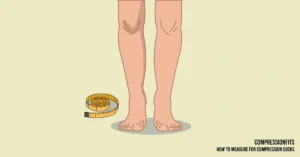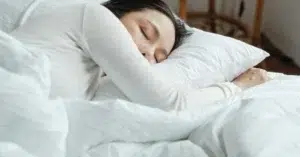Are you a member of the nursing profession? Nursing may be a laborious job, often requiring prolonged periods of standing and little time for rest. Despite facing prolonged discomfort, nurses prioritize the well-being of their patients above their own ease.
While enduring such challenges, nurses remain dedicated to ensuring the comfort of those under their care. To ease their discomfort, wearing compression socks can be incredibly beneficial. These socks are specifically designed to increase blood circulation in the legs, providing a gentle yet supportive grip.
In this article, you’ll learn all the essentials about compression socks for nurses and why every nurse should consider incorporating them into their daily routines. Let’s dive in!

All About Compression Socks for Nurses
Compression stockings, or compression socks, apply pressure to your lower legs to help blood flow better, reduce swelling, and make you feel more comfortable.
They can prevent the accumulation of blood and fluids in the legs and relieve other conditions like varicose veins, skin ulcers, and deep vein thrombosis (blood clots in the leg).
Unlike regular socks, compression socks for nurses are much tighter and are made of stretchy material that is strongest at your feet and ankles, then gets looser as they go up your leg towards your knee.

Source: https://blog.columbusmedicalassociation.org/blog-1/2022/1/14/how-compression-stockings-can-change-the-way-you-feel-and-improve-your-health
They squeeze your legs lightly to help blood return to the heart and come in various sizes and strengths; you can buy them over the counter, or your doctor can prescribe them for you.
If you suffer from a condition like varicose or spider veins that slow blood flow in your legs, a doctor may prescribe compression stockings to you.
On the flip side, these socks are usually manufactured from blends of synthetic fabrics such as nylon, spandex, or polyester. These fabrics provide the elasticity necessary for proper compression as well as comfort.
While the use of these socks won’t disturb your sleep, the moderate to firm ones may cause inflammation in your legs when you put them on at night.
Are Compression Socks Just Tight Socks?
Compression socks are far more than just tight socks. Although they may feel tight, their effectiveness lies in their specialized design.
These socks are special because they squeeze your legs a bit more at the ankle and loosen up as they go towards your knee.
This fancy way of squeezing (called graduated compression) helps your blood flow better back to your heart instead of getting stuck in your lower legs. That’s why they’re great for fighting swollen, tired legs and general discomfort.
Don’t worry, though, they’re not going to strangle your legs! They should feel snug but comfortable, kind of like a gentle massage for your muscles.
Unlike your regular socks, these compression socks give you the extra benefit of improved circulation and leg support, all while keeping you comfy.
To top it all off, compression socks come in different strengths, so you can find a pair that’s just right for your needs.

From mild compression for everyday wear to higher compression for medical conditions, there’s a wide range of options available to cater to individual preferences and requirements.
Why Is Wearing Compression Socks Good for Nurses?
Nurses know the feeling – being on your feet all day can be a drag! Gravity becomes a bit of a foe, causing blood to pool in your lower legs instead of flowing back to your heart as it should. This can make those long shifts feel even longer and leave your legs feeling achy and tired by the end of the day.
Here’s where compression socks come in as your secret weapon! They work like a gentle hug for your legs, helping blood circulate better. Think of it as a way to give your hardworking legs a helping hand throughout your shift.
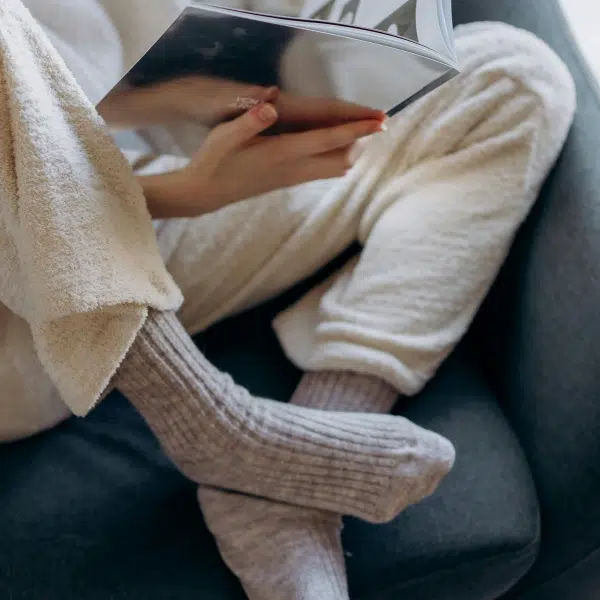
So, here are some of the reasons why nurses must wear compression socks:
Leg Pain
Nurses are usually forced to spend an extended amount of time standing, and gravity makes it hard for blood to fight and go back to the heart. This results in swollen legs and blood pooling, making your legs feel sore and achy.
Compression stockings do a great job of alleviating pain and discomfort in the legs or feet, even after long hours of work. These are specially designed for nurses, which may help them feel less weight and leg fatigue and even avoid foot and ankle soreness and injuries.
Muscle Recovery
Compression socks play a crucial role as they reduce muscle tiredness in the legs and enhance circulation, preventing discomfort in the legs. They can also help reduce muscle damage from exercise.

Some say these socks have a greater recovery effect after strength training than running or cycling. Compression socks should feel firm but not uncomfortable; too tight socks can cut off circulation.
Varicose Veins
If you stand for long periods every day, you could end up with blisters, varicose, or spider veins because of venous stasis. But don’t worry! There’s a solution.
Wearing graduated compression socks may help to prevent varicose veins by forcing blood up the leg and towards the heart rather than the blood pooling up in the veins.
Swelling Naturally Occurs
According to healthcare experts, standing for 12 hours straight can cause swelling in your lower legs, which can make it tough to work comfortably.
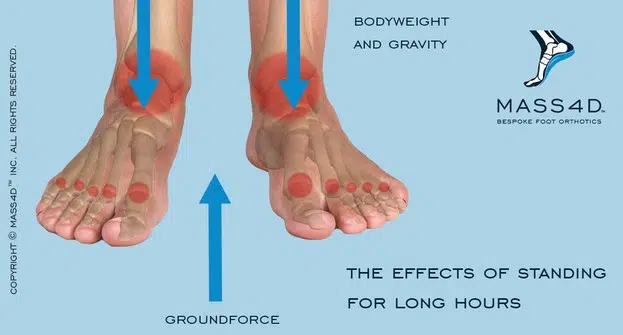
But here’s the good news: wearing compression socks can help. They support the muscles in your legs and reduce swelling in your ankles and feet. Plus, they stop fluid from building up in your legs, which is a big reason for swelling.
Increasing Comfort
For nurses, wearing compression socks is essential for immediate comfort and relaxation after a long day. They enhance comfort during prolonged periods of walking and standing and provide relief once you’re home.
The primary advantage of compression socks is their ability to alleviate fatigue and discomfort throughout the day. By counteracting the effects of gravity on blood flow and lymphatic fluid in the lower extremities, they play a crucial role in maintaining circulation.
Many healthcare experts assure you that wearing compression stockings doesn’t come with serious risks or side effects. For the best results, opt for socks that fit comfortably and are made from suitable materials. Wear them during the busiest times of your day to maximize their benefits.
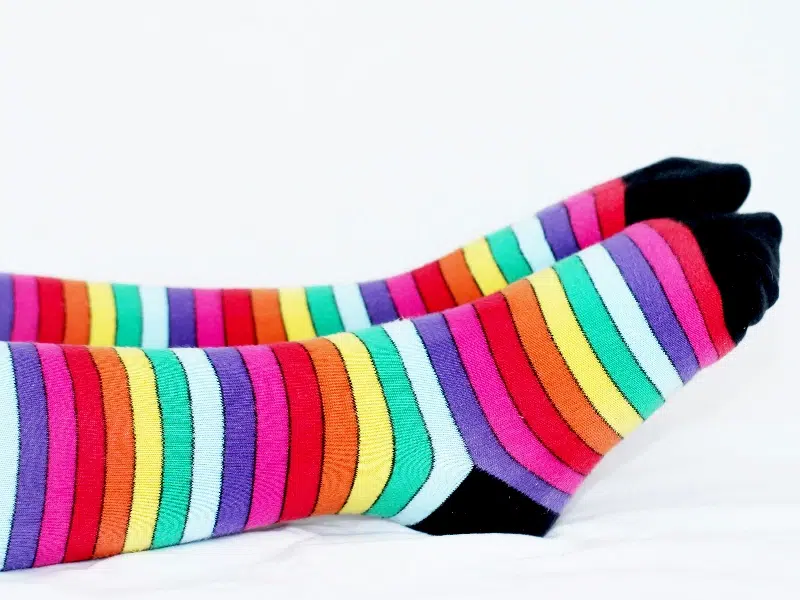
Compression Socks Vs. Regular Socks
| Aspect | Regular Socks | Compression Socks |
| Purpose | Made for comfort and softness, with no specific medical purpose | Improve circulation, reduce swelling, and provide support |
| Compression Level | No compression features, primarily provide warmth and protection | Offers graduated compression to enhance blood flow |
| Muscle Recovery | There are no specific benefits for muscle recovery | Aids in muscle recovery with added oxygen and nutrients |
| Suitable Users | Suitable for everyday wear by anyone | Athletes, those on their feet all day, medical needs |
| Fabric Composition | Made from fabrics like cotton, wool, silk, linen, and mohair for comfort | Typically made of elastic or spandex blends for compression effectiveness |
| Specialized Benefits | Have no specialized medical benefits | Prevents fatigue, edema, and varicose veins; reduces pain |
| Medical Benefits | Do not have any specific scientific backing for medical benefits | Supported by studies (NCBI) showing effectiveness in improving circulation and reducing symptoms |
Best Compression Socks For Nurses
What’s most comfortable varies among nurses based on their individual preferences. However, compression stockings are essential for nurses rather than just tight socks, as they promote healthy circulation and minimize fatigue or strain in the lower legs.
For optimal effectiveness, it’s important to wear them regularly, so finding a comfortable pair is key. Let’s explore some of the best compression socks for nurses:
Nurse Mates Compression Socks
Nurse Mates compression socks are specially crafted to offer graduated compression and support for medical professionals who spend long hours on their feet. They come in ankle and knee-high varieties and are designed to be worn with comfortable shoes.

Photo by Nurse Mates
PRO Compression Socks
PRO Compression socks are designed to improve performance and recovery, alleviate pain, reduce swelling, and enhance circulation to the feet.
They are made with high-quality microfibers and offer compression levels between 10 mmHg and 30 mmHg. These socks gently squeeze your legs and ankles, which can boost blood flow from your legs back to your heart.
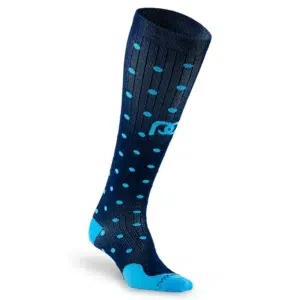
Photo by PRO Compression
FIGS Compression Socks
FIGS compression socks are specially manufactured to relieve achy and tired legs. They boast 360° seamless compression, along with padding at the toes and heels, and are made from sustainably sourced yarn. They are breathable and soft, can relieve pain, and absorb shock.
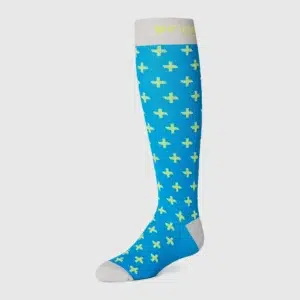
Photo by FIGS
Bombas Women’s Everyday Compression Socks
These socks offer medium compression and are comfortable enough to provide support throughout the day. These compression socks are made with extra-long staple cotton, a premium fiber that is smooth, soft, and durable.
They have a 15–20 mmHg compression level and are designed to relieve tired legs and aching or swollen feet. Its shape makes it the best compression socks for nurses overall.

Photo by Bombas
Healthcare professionals say there are no serious risks or side effects of wearing these socks, but to get the most benefit, find a pair of compression socks for nurses with a comfortable length and material and wear them during the most active parts of your day.
Things To Consider When Choosing Compression Socks
When choosing compression socks for nurses, you can consider things like:

- Compression level: Improper use of compression socks can be ineffective or potentially harmful. These socks are rated for their different levels, so choose a design that suits your activity. Some of these offer light, medium, or firm compression. For example, active nurses may want to choose a milder compression sock with a level of 8–15 mmHg.
- Size: Sizing, especially around the calf, is essential. You should select a sock after ensuring that it fits your legs perfectly. Some compression socks, like tights or leggings, are snug and flexible, while others are easy to pull on and off.
- Comfort: Compression socks should feel like a gentle squeeze and not cause pain or tingling. You can also consider whether the socks are made with a breathable fabric, if they have a seamless toe, or if you require any other comfort factor from your socks.
What Compression Level is Right for Nurses?
Depending on their needs, nurses can benefit from different levels of graduated pressure that might help them with mild swelling.
Many young nurses begin with light to moderate compression, while others may opt for a firmer level of compression. Here are some compression levels and their uses:
- 10-15 mmHg: Light and mild compression that provides gentle support while walking or lounging
- 15-20 mmHg: Mid-grade compression that can promote muscle recovery and is suitable for nurses who are on their feet all-day
- 20-30 mmHg: High-level, medical-grade compression that provides next-level support
- 30+ mmHg: Extra-firm compression that should only be worn when prescribed by healthcare professionals to treat certain health conditions
Nurses can start with 15-20 mmHg compression and work up to 20-30 mmHg as needed. Ultimately, it’s all about finding what feels most comfortable all day and provides the most relief for your legs after work.
Wrapping Up
Compression socks offer more than just practical benefits for nurses, like reducing swelling and discomfort. Plus, they also let nurses add some fun and personality to their work attire.
The addition of these crazy compression socks for nurses can bring a touch of joy to any nursing environment, particularly in pediatric settings where a little extra cheer is always appreciated.
After all, looking good makes you feel good – and in the working and exciting nursing profession, that positivity may go a long way.
